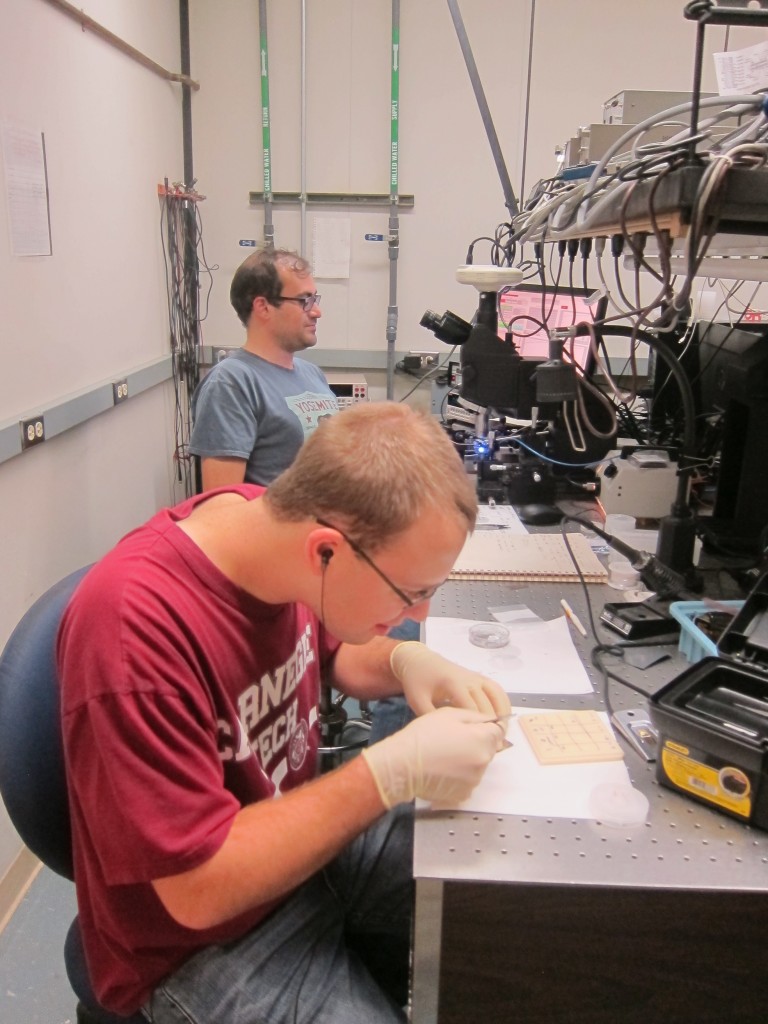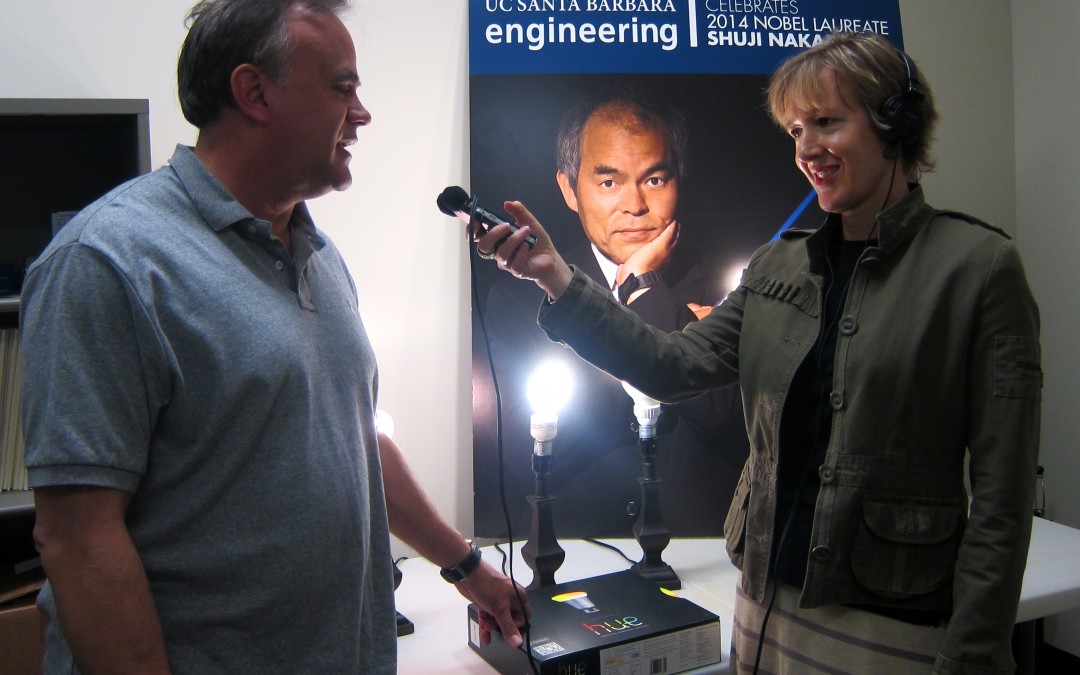This week, UC Santa Barbara’s Professor Nakamura (and two colleagues in Japan) received the Nobel Prize for Physics. Their big breakthrough? The Holy Grail of material science for many years: Blue LED technology. It not only enables high efficiency lighting (goodbye Edison’s incandescent bulbs, hello backlit smartphones, and 2300 feet headlights); but one day soon will help double the range of hybrid cars (thanks to its power switching applications).
Today BBC’s Tech Tent aired my interview with Professor Steven DenBaars, research partner to Professor Nakamura at UCSB.
A version of this story aired on BBC’s Tech Tent on Dec. 12, 2014. Listen to the podcast below:
To give you a sense of just how energy efficient these LED lightbulbs are, Prof DenBaars claims that if everyone in the United States replaced their old bulbs with LEDs, it would reduce the country’s electric light bill from $100 Billion to $20 Billion. Impressive.
Sweden’s Per Delsing gives it a global perspective: “A quarter of all energy consumption goes to illumination,” he said at the Nobel Prize press conference. As a result, any increase in efficiency and consequent saving of energy “is really going to have a big impact on modern civilization.”
While reporting for the BBC, I got a fascinating tour of UCSB’s Solid State Lighting and Energy Center and a chemistry lesson from Steven Griffiths, a grad student researcher. His colleagues Sang Ho Oh and Daniel Becerra also contributed valuable background information (see below for more photos).
Here’s a transcript of my conversation with Prof Denbaars (aka: all you ever wanted to know about LEDs but were afraid to ask):
Alison van D: I’m here at the Uni of California Santa Barbara with the research team led by Prof Nakamura, the winner of this year’s Nobel prize for Physics. He earned the Nobel Prize for his blue LED breakthrough. I want to talk with Dr Steven Denbaars who is a research partner of the professor and start with the basics. What is an LED?
Prof DenBaars: An LED stands for a light emitting diode, it’s basically a semiconductor crystal which glows bright light, in this case, bright blue light when you apply electrical current to it.
van D: Can you explain how they’re used in smartphones, computer screens and in lighting?
Prof D: OK in smartphones the LED is used in combination with a phosphor on top of it to generate white light. That is, the blue is converted with a red and a green phosphor to produce a full spectrum of white light. That is the white light in your flashlight, you know when you take a picture, but it’s also the white light in back of your LCD screen. So it’s called the backlight. So all smart phones today use LED backlighting to do energy efficient displays.
van D: And tell me about the lighting aspect. Is it just the LED bulbs you find at the supermarket, is that the only application for LEDs in the lighting sphere?
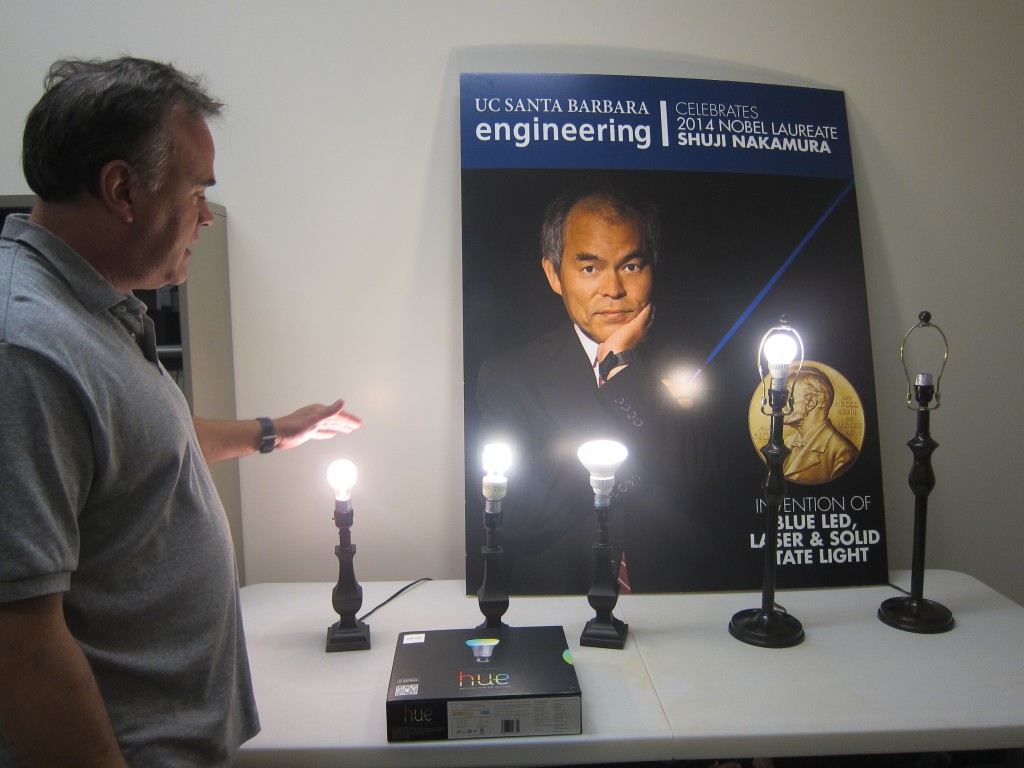 Prof D: Well that was the initial implementation, a bulb replacement or retrofit. But what we’re seeing is: now you can use the LED to add additional features to lighting, such as communications. That is, you can have your cell phone control the color of the light bulb or even communicate information between the light bulb and your cell phone or maybe even your Internet server to distribute information into the house. That’s just starting. We call that smart LED lighting.
Prof D: Well that was the initial implementation, a bulb replacement or retrofit. But what we’re seeing is: now you can use the LED to add additional features to lighting, such as communications. That is, you can have your cell phone control the color of the light bulb or even communicate information between the light bulb and your cell phone or maybe even your Internet server to distribute information into the house. That’s just starting. We call that smart LED lighting.
van D: So can you explain how that works? You get an app on your phone and you can change the mood lighting of your home?
Prof D: Yes, you can change the color temperature from a sunset to a cold day in Sweden, maybe, I guess. 6500 Kelvin would look very bluish white…That is using the Bluetooth feature on your iPhone that communicates with the chip in the light bulb, which then changes the mix of the colors in the LED.
van D: Can you talk about the particular breakthrough?
Prof D: Both Akasaki, Amano and Nakamura basically developed the P-type Gallium Nitride which was the missing link in the quest for the Holy Grail of LEDs at the time. We had red and green, we didn’t have blue.
van D: And why was that the Holy Grail?
Prof D: The blue was the Holy Grail because…if you have a paint brush and you only have red and green, then you can’t make a painting, correctly replicate the visible spectrum. So we were missing a huge chunk of the visible spectrum. People have been looking for 40 years for the right blue illuminating semi conductor …
van D: So do you see in the future, is this LED technology going to completely replace Thomas Edison’s incandescent bulb?
Prof D: Well I think it will definitely become the dominant light source. The quality of the light is winning over the consumer, it’s very close to an incandescent as you can see from this demo here…we have a bulb from a US manufacturer which looks almost exactly like a normal light bulb. I think there will still be some uses where people still really like incandescent lighting but that’ll be more for design or decorative reasons. Basically, if you want to have a long life light bulb…that’s the other advantage, these things last for 20 to 50 years. An incandescent light bulb lasts 6 months. So you’re really throwing your money away when you buy an incandescent light bulb. The US spends about $100 B for electricity for lighting and LEDs could take that down to about $20 B, so we could save the US $80 B in electrical costs if we switched over to LEDs, if everybody switched over today.
van D: Tell me about the LED laser headlights
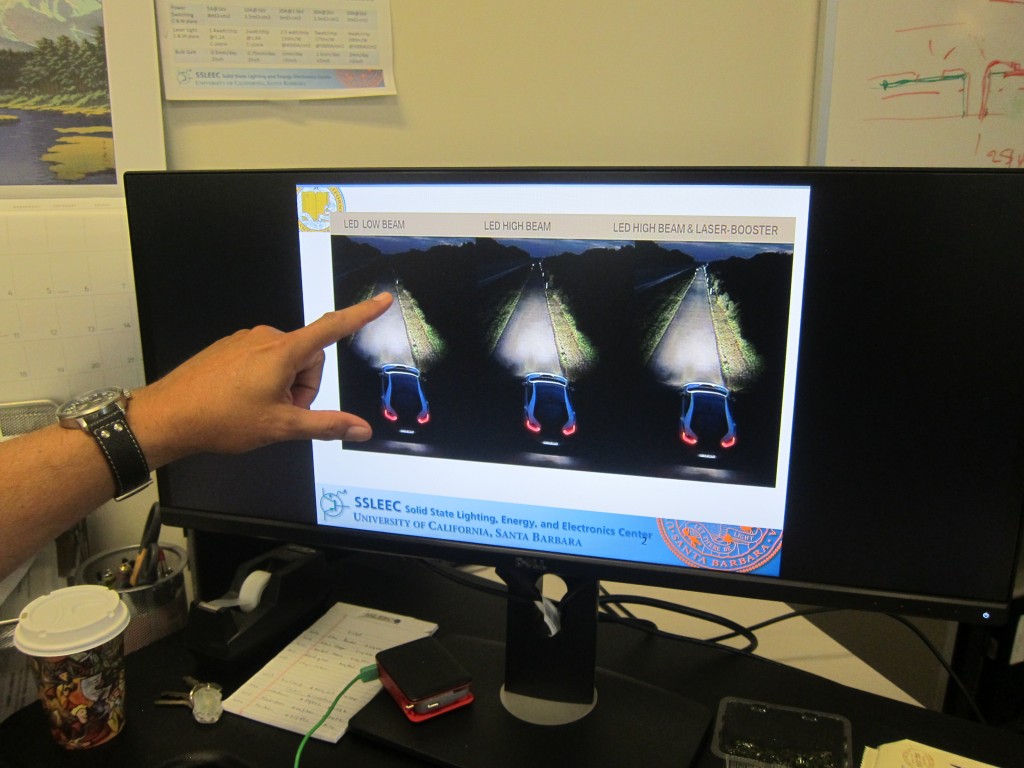 Prof D: The laser headlight…you can see 700 meters in front of the car. Normal headlight is 150 meters. So you may think that this is going to scare the other driver, be bright, but it’s not any brighter to the other driver…it can be more tightly focused and columnated, projected on to the road. So this is a big safety advantage and it’s actually been released by BMW and Audi in Germany. Several thousand dollars per headlight but it’s a safety feature, because on the autobahn you drive about 240 K an hour, so you want to see 700 meters….
Prof D: The laser headlight…you can see 700 meters in front of the car. Normal headlight is 150 meters. So you may think that this is going to scare the other driver, be bright, but it’s not any brighter to the other driver…it can be more tightly focused and columnated, projected on to the road. So this is a big safety advantage and it’s actually been released by BMW and Audi in Germany. Several thousand dollars per headlight but it’s a safety feature, because on the autobahn you drive about 240 K an hour, so you want to see 700 meters….
van D: So do you see that trickling through to all new cars within 5 years?
Prof D: Wow. The automobile industry is usually very slow to adapt. The LED headlight took about 5 to 7 years. Now you can see LED day-running lights everywhere, all newer cars. But the laser, which is the next generation of this lighting, will take 5 to 10 years.
van D: And what are you personally most excited about for the future of LEDs?
Prof D: Wow. I think it’s just to now be able to make a light bulb that’s smart enough to communicate, turn on and off when you need it. That’s very exciting. But also I think the real promise is: we can take lighting off grid. That is, you can make the LED, when you combine it with a solar cell completely renewable. That is, you just generate the electricity you want with a solar cell like this little solar powered LED lamp I have here, and therefore you don’t need electricity any more. Your light source, you just carry around with you. During the day time it charges up with a solar cell and at night it comes on. That would be the Holy Grail. We can become completely sustainable lighting without having to use electricity. This has the potential to save the world a couple hundred power plants of energy. More than a hundred nuclear power plants.
van D: Finally Professor Denbaars, is there anything else that you would like to share with the BBC listening audience?
Prof D: In electric cars it turns out you can use this as the power switching device (the thing that switches from the battery to the electric drive). Professor Nakamura and myself are also looking at it for power electronics. So Shuji’s (Nakamura) fundamental breakthrough of an LED is now impacting three major areas: not just lighting but it’s impacting displays, but now even electric cars.
van D: And how does that work? If you’re driving a Tesla or a Nissan Leaf, how is this LED technology going to make things better?
Prof D: I saw projections…it would take the Toyota Prius – which gets about 55 mpg – now the hybrid technology it would make it over 120 mpg…because it’s so efficient.
van D: How soon might we see this?
Prof D: This is a much harder problem to solve cos we’ve got to get the cost down and the scale up of the Gallium Nitride power electronics. I’ve seen lab demos… generally from lab demos to implementation it’s 5 years in this field of solid state that I work in.
van D: Are you already talking with Tesla and Nissan…?
Prof D: I can’t comment at all which car companies. But yes, we’re talking with car companies…they’re looking at it and the US government is putting a significant amount of money into this field. It’s called power electronics.
van D: Fantastic thank you.
And the research goes on. Researcher Steven Griffiths and his colleagues are working on further improvements in the Gallium Nitride (GaN) material to produce even higher efficiency LEDs and power swtiching. Below:
- A pure nitrogen-containing glovebox is used to handle chemicals which are reactive in air.
- The glovebox is used for alkali metals and ammonium salts, which are added to the reactors to aid in GaN growth.
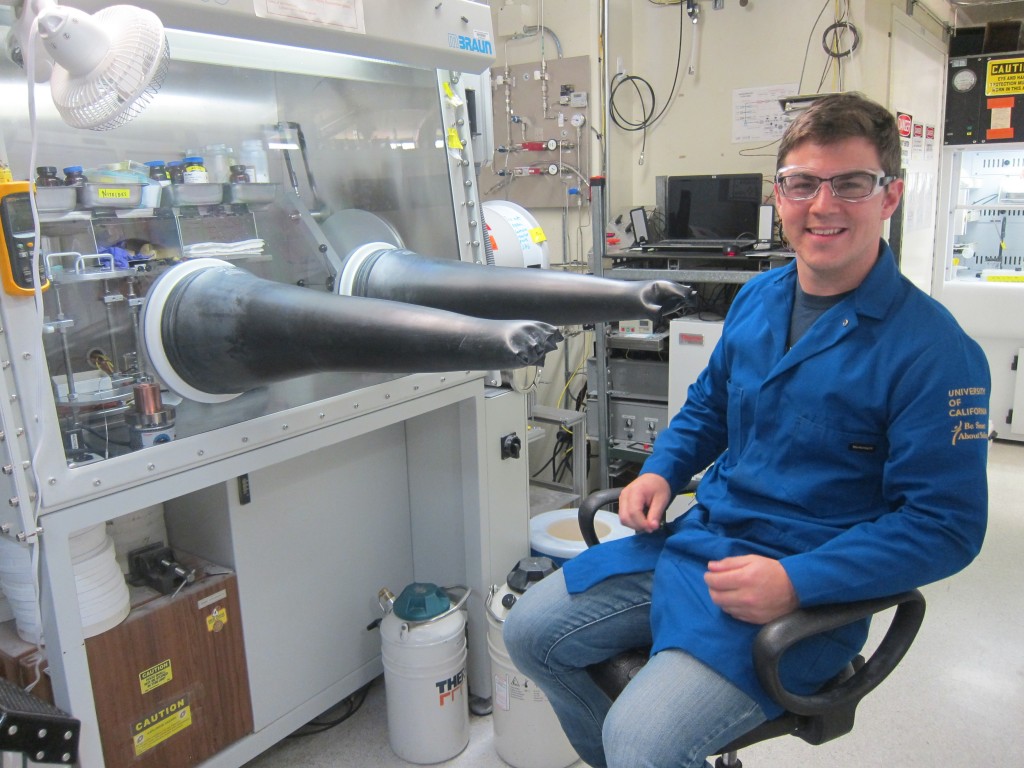
Below: Steven Griffiths shows the interior of a blast containment vessel, which when in operation contains ammonothermal reactors (not pictured) used to grow large gallium nitride (GaN) crystals. The blue vessel is the “blast containment vessel”, to “crush cans” (which dissipate projectile energy in the case of an explosion). The white cylinders are heaters, in which the “ammonothermal reactors” (not pictured) are placed when in operation. The blast containment vessels must be sealed due to the extreme temperatures (>500°C) and pressures (>2000 atm.) used for ammonothermal GaN growth. Ammonothermal growth uses large quantities of ammonia at the extreme conditions mentioned, therefore researchers in the lab space must be protected from explosion, fire, and chemical hazards.
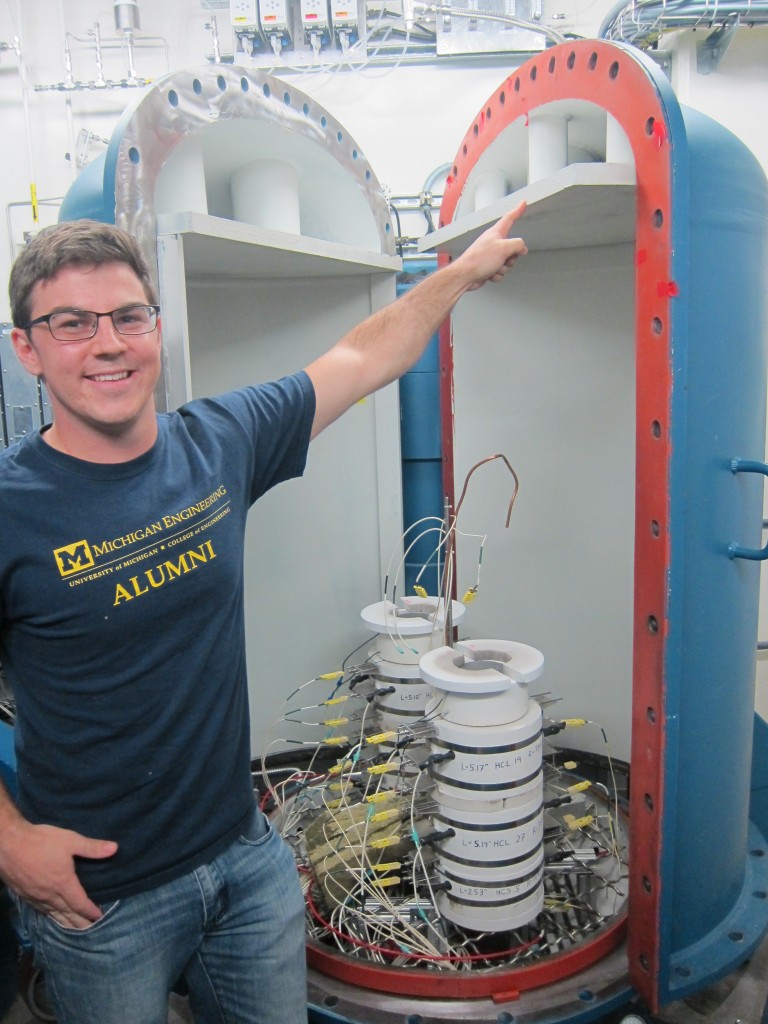
Below: Blue light emission from an LED. Blue light is produced when a bias is applied across the LED. Blue LEDs are composed of indium gallium nitride (InGaN) active layers sandwiched between positive (p-type) and negative (n-type) GaN layers, all of which are grown on a native (GaN) or foreign (Si, silicon carbide, sapphire, or gallium arsenide) substrate.
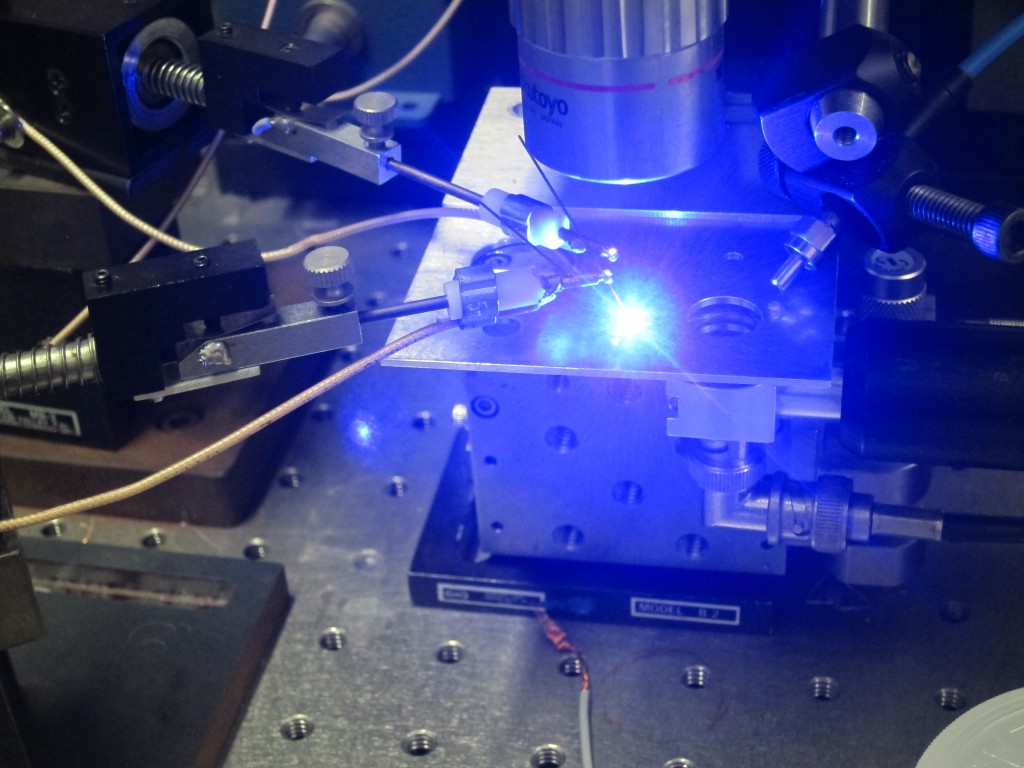
Below: Burhan Saifaddin (background) and Dan Becerra (foreground). The performance of blue LEDs is tested after crystal growth and device processing. Dan is applying metal to make electrical contact with the positive and negative terminals of the LEDs. Burhan is energizing the LEDs and monitoring their electrical operation/emission characteristics.